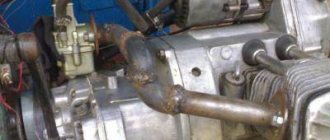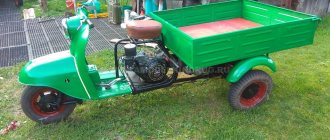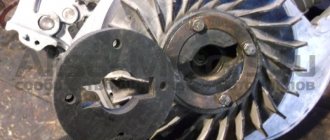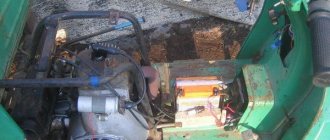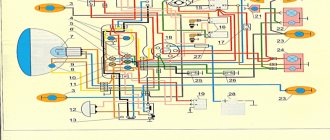The Ant is, although old, quite versatile and still relevant for many scooter owners. It can be useful both in urban conditions and for work in rural areas. It was precisely to help summer residents and garden owners that this technique was originally created. But a scooter is also perfect as a city vehicle.
The factory design and structure of the Ant cannot be called perfect. Many solutions are morally and technically outdated. Those who like to experiment, modernize and refine equipment often come across this particular scooter.
A popular solution in terms of some technical improvement of the Ant is the installation of a magneto or contactless ignition. This is actually a solid module that needs to be placed in the right place and connected. There is nothing fundamentally difficult in this task. The only question is whether this is a feasible solution.
Making your own scooter air filter
Making a scooter air filter with your own hands
The background of the creep is quite prosaic. A friend had a “damn the kitten” problem with the piston, crankshaft, connecting rod, pin, in general, everything that makes the moped move, the engine on the 24 died, and seriously. The recently held first races on a seagull on a scooter inspired heroic deeds.
As a result, a friend buys a 65cc piston (Honda Takt AF24), a new crankshaft, and makes capital investments, since everything still needs to be changed. Well, after driving 300 kilometers, he complains that he doesn’t feel like he has 65 cc. Accordingly, I give him a bunch of links to engine tuning.
In short, after sitting in the evening, drinking beer, we decided to fire up his apparatus. Since I’m still calculating the pipe (I’m checking different calculation options - so that they match, otherwise I don’t want to buy Leovinci or something like that - it’s expensive) - but we’ll do it anyway. In the end, we decided to make the intake easier. Again, I’m reluctant to buy a zero-resistance filter for 250-300 g. So I was drawn to the garage to “go crazy.” About two years ago, I installed a homemade filter for a friend of mine on his Yamaha Jog-Sekogd Edition (an old guy with a vertical motor), since my dear one simply got lost. I was guided by an article from the St. Petersburg site moto.km.ru
In general, the reliability of the filter element has been tested the hard way, over 2 years, without replacing the housing. It was decided, based on experience, to assemble a fan that was more practical to use and reliable to install.
As a result, having come to the market, it was purchased: Oil filter for Moskvich KS-71 (411-412 Muscovites) - 4 g.
Siphon for washbasin - from 5g to 21g. (you need to choose from elastic plastic or with polyethylene impurities - in general, pure polyvinyl chloride will not work - it’s too fragile), although the siphon itself is not needed so much as its upper part - and some at the market sell it separately.
The second aspect when choosing a siphon is that a filter should be inserted into its neck diameter.
An M6 hairpin with a length of 220-250mm is selected experimentally. I purchased a mounting anchor of suitable length, since I didn’t have time to look for a hairpin for a long time. For 2.50 UAH.
Well, and, accordingly, a creative accelerator with a capacity of 1 liter. each. — 3.80 UAH each. :O)
I don’t count the mounting silicone and self-adhesive micropork, because it was available in the garage. Oh, and, of course, two clamps with a diameter of 25-32mm for as much as 1 UAH.
As a result, the idea is as follows:
That is, the filter element, without any modifications, is clamped between the neck of the siphon and its counterpart (a metal round flange with a bunch of holes), the whole thing is pulled together with the same hairpin, the length of which is selected according to the location, you should not leave a very long section of the hairpin, it will go into the air intake pipe and may rest against the carburetor.
Next, we make a plug - a plug for the response hole in the filter element.
The procedure is as follows: We take our throat from the siphon and heat its narrow part (that is, the pipe) with a hairdryer, pull it onto a plastic bottle cap (I pulled it onto a Coca-Cola cap, it has a more or less cylindrical shape). We cut off the resulting plug from the throat of the siphon. It should fit as close as possible into the filter hole. Next, we take our siphon in our hands and from under the clamping nut of the siphon neck we take out the silicone sealing ring, which we put on our plug. As a result, this ring ensures reliable sealing of the hole in the filter element. Everything is clear from the photograph:
We make a hole in the center of the cork and string it onto a pin, starting with the flange (lid) of the siphon neck into which our cork is inserted.
To ensure that the ring does not fall off and the structure has a more civil appearance, we fill the gap between the metal lid and the plug with silicone. To ensure an even tighter seal between the cork and the pin, the cavity in the cork can also be treated with silicone and a series of rubber washers can be put on and secured inside the cap with glue or the same silicone.
Tuning a scooter's variator - theory and practice
I hasten to disappoint some readers. In this article, you will not find a “super-duper” manual for sawing a variator a la “Hello everyone! Today Evgeny Matveev is with you” - don’t even hope! Especially for you, on YouTube, there are several videos that show this work in accordance with the canons of Feng Shui. You go to YouTube, the rest of the readers sit back and listen. In general, as they say: “boys to the right, girls to the left.”
Basic concept: Many scooter drivers mistakenly believe that tuning a scooter (variator) comes down solely to sawing it - everything else is a tricky one. Our mentality is partly to blame for this belief: they say a tuning kit or a set of rollers costs money, and I seem to have a file in the shed - so why pay then?
No, my dears, sawing a variator is not tuning. This activity, from the outside, looks very much like old and cheap porn... Good tuning costs money, no matter how much you would like to think differently - this will be the main concept of today’s article.
Theory: There is no point in telling how the variator works, since this topic has already been “sucked” up and down on other thematic resources. For beginners, we advise you to search for information on YouTube, where there are very good videos showing the principle of operation of the variator.
A scooter's variator is an automatic type of transmission, its task is to increase or decrease the transmission gear ratio without a stepwise method, to ensure the most efficient acceleration of the scooter (dynamics), ease of control, and efficiency. That is, to put it simply: the variator, depending on engine speed and driving speed in automatic mode, provides the optimal transmission ratio at a certain point in time.
Unfortunately, budget scooters are equipped with a mechanical CVT. That is, the operation of the variator is controlled using rollers, which, under the influence of centrifugal force, control the operation of the variator, thereby increasing or decreasing the transmission gear ratio.
This technical solution has proven itself from the best side, due to its low cost, simplicity and reliability - you can’t argue with that. But! Any mechanical device has a certain moment of inertia; frictional forces and temperature also have a great influence on the operation of such devices. Therefore, the mechanical type of variator works in steps; it is not able to instantly respond to changes in engine speed and other parameters. Because of this, dips appear in the operation of the scooter, dynamics deteriorate and power decreases.
Manufacturers of branded scooters have long been using a CVT controlled by an on-board computer in the transmission. This type of variator (electronically controlled) has an almost perfectly smooth operating characteristic, providing the scooter with high dynamics, ease of control and efficiency.
In our country, such scooters are still poorly represented, but we want dynamics and comfort in handling, so a logical question arises: how to squeeze the maximum capabilities out of the standard mechanical type variator installed on most scooters?
The answer is simple: install variator rollers optimally selected for weight or buy a ready-made kit (set), which will provide smoother performance and a slight increase in the power and dynamics of the scooter.
The rollers are sold as a set; the packaging indicates their size and, most importantly, their weight. Depending on the model of your scooter, you can buy roller skates that completely satisfy your preferences. The price of the sets presented below fluctuates around 250-300 rubles.
Here you see rollers of the same size, only much heavier than the previous set, the price is the same 250-300 rubles.
Let's consider both options in more detail: When choosing a tuning option, you need to start from a specific task, that is, what do we want to get in the end?
If you want to get high power (torque) of the scooter, then you should change the rollers to lighter ones - this action can increase the traction of the scooter throughout the entire engine speed range, slightly improve the dynamics, but the maximum speed will decrease significantly.
If you want to get an even characteristic in the middle range of engine speeds, then there is no clear solution; here you need to experiment with the weight of the rollers, both higher and lower.
Heavier rollers are installed only if you have done engine tuning, that is, increased the maximum power and speed. There is no point in installing heavy rollers on a stock engine, since in this case you will be guaranteed prolonged failures during acceleration of the scooter.
It is almost impossible to give the optimal weight values of variator rollers for each scooter model within the framework of this article, since there are a great many scooter models and each model has its own denomination. You understand...
It is worth noting that the selection of CVT rollers is the lot of experienced scooter drivers who have already tasted the drive, know many important points, and feel their scooter like their own. Therefore, for beginners, it is better to buy a ready-made tuning kit, which includes a set of rollers of optimal weight along with a CVT of an improved design.
Such whales have very positive reviews among the people; they provide smooth operation, good dynamics, and economy, which is just right for city traffic. The price for such a kit starts from 1200 rubles and above, yes, it is expensive, but the ride comfort, efficiency and dynamics more than compensate for the money spent.
You should know: a tuning kit works well on a stock engine; if you “charged” the engine, then such a kit will not provide the desired result. Here we must make a reservation: there are also whales that are specially designed for “charged” engines, but we are not talking about them today.
Tuning the rear variator: what can I say? Installing tuning springs (more rigid) in terms of dynamics, control comfort and efficiency of a scooter equipped with a stock engine essentially does nothing. Tuning the rear variator is only worth it if you have hard-charged the engine - then yes, there will be an effect from installing hard springs!
And so... There is no point in installing stiff variator and clutch springs for a stock engine.
Air filter on a scooter
As you know, in a scooter engine, during its operation, it is not just gasoline that burns, but a mixture of gasoline and air, prepared in a certain proportion by the carburetor. Without atmospheric oxygen, gasoline simply cannot burn. If the fuel passes through a fine fuel filter before entering the engine, the air is cleaned by the air filter. If air purification is not carried out efficiently, then particles of dust and other contaminants will very quickly lead to wear of engine parts, especially for parts of the cylinder-piston group. In addition to the quality of cleaning, a very important indicator for an air filter is its resistance to air flow. This parameter must match the engine settings, otherwise engine operation will be disrupted.
It is impossible not to mention the so-called zero-resistance air filters, which some scooterists install on their equipment when tuning. Indeed, such filters increase engine power, since the engine “breathes” more freely and does not have to overcome air resistance at the inlet. But, at the same time, such filters filter the air very poorly, therefore, the engine life is reduced. It makes sense to use “nulevik” filters only on sports equipment, where it is important to win a competition, and where the life of the engine is not at issue.
The air filter has another function - reducing engine noise. If you have seen and disassembled the air filter housing of a scooter, you may have noticed that its design is not as simple as it seems at first. Chambers and partitions can be placed inside the case; the shape of the case itself is quite complex. Indeed, the filter housing is specially designed to participate in dampening the sound of the engine, just like the muffler. Any disturbances in the intake or exhaust system can not only “add a decibel” to the running engine, but also change the engine settings, which will disrupt its operation. Two-stroke engines are especially sensitive to interference in the intake or exhaust system.
Now let's look at the types of air filters used on scooters. These can be either foam rubber, paper, or metal filters. Foam filters can be either multi-layer or single-layer. When dirty, such a filter can be easily cleaned by washing it in gasoline or detergent. After this, you must soak the foam filter element in engine oil, or apply a special composition for impregnating air filters to the foam rubber. You can treat foam rubber with oil like this: pour a little oil into a plastic bag, place a clean filter element there, knead the bag with the foam rubber in your hands so that the oil saturates it throughout its entire thickness. After this, squeeze out the foam, removing excess oil from it, and install the filter in place. The foam rubber should be completely saturated with oil, but oil should not drip from it. It is impossible to install a “dry” foam filter without impregnation with oil, since high-quality air purification will not be ensured. Over time, after a certain number of such cleanings, the foam filter element becomes unusable and must be replaced. By the way, make sure that the foam filter element is intact and that it is installed correctly in the filter housing so that even a small amount of unpurified air cannot enter the engine.
What are the advantages of replacing a CVT with a sports one on a Chinese scooter?
Professional motorcyclists consider the Chinese scooter to be low-dynamic. They especially do not favor models equipped with a four-stroke engine with a capacity of less than 50cc. Most of these scooters have a 139QMB engine, which is easy to buy because any motorcycle parts store has this modification on its shelves. This engine itself is a very successful design, because it is exactly copied from Honda engines. Today, this concern has stopped producing such engines, but Chinese manufacturers have very actively taken up its production, appreciating the low cost of the motorcycle part.
Extreme scooterists believe that they still couldn’t catch up with the Honda analogue 139QMB, so its characteristics are not entirely suitable for aggressive driving. But lovers of “normal” driving have long appreciated its performance qualities and consider it the best of the “Chinese” today.
To improve its dynamics and speed, there are several proven options. But we will consider one: replacing the factory CVT with a sports one in models with a 139QMB engine.
Benefits obtained by tuning a scooter's variator
The “native” transmission of Chinese scooters implies a strictly defined engine size, exceeding which is strongly not recommended. In addition, the most frequent drivers of Chinese small-capacity motorcycles are women and the elderly, but young people (especially having already gained some driving experience) tend to acquire more extreme motorcycles, so those rather mild indicators in terms of speed and dynamics are absolutely justified. There is no sudden acceleration, explosions or frantic dynamics. The maximum possible speed that can be squeezed out of a scooter's variator is strictly limited by the cutoff in the switch and its technical capabilities. In other words, once the belt drive pulley reaches its maximum radius, increasing the speed will simply not be possible. Unless there is a significant increase in speed or a complete replacement of the gearbox, the purchase of which involves large investments. Moreover, buying a new motorcycle part is not at all difficult, the main thing is to choose a trusted motorcycle parts store, but finding a specialist who will competently carry out the entire replacement procedure is much more difficult.
You can increase the speed in a less budgetary way: by replacing the CVT with a sports one, which will eliminate all failures at medium speeds. From this, the dynamic performance will improve significantly, increasing the maximum possible speed.
How to replace a variator in practice
Specialists who replace stock motorcycle parts with tuning ones do not pay any attention to either the legislation or the manufacturers' recommendations regarding a strictly defined engine size. They do not adhere to any rules, except one: to maximize the full potential of the transmission. Of course, each individual Chinese scooter differs from any other in its characteristics developed during operation. It has its own engine wear, its own condition of components and assemblies, therefore we cannot recommend a standard set consisting of a variator, rollers, bushings and springs for each model with a 139QMB engine. Each modification often includes several sets of the same rollers, and only by choosing the most suitable ones can the correct adjustment of the pulley be carried out.
The optimal tuning for a scooter's CVT on a 139QMB engine is considered to be replacing the piston with a larger one (82 cubic centimeters). After its implementation, the output is the best return from an operational point of view. And from the financial side too.
You shouldn’t install motorcycle parts on a Chinese scooter, the cost of which is equal to half the cost of the “iron horse” itself, so the best option would be budget Chinese and Taiwanese motorcycle parts. Such sports CVTs are equipped with several pairs of rollers of different weights, clutch springs and bushings. The price of such a complete set starts at $40, and its speed capabilities far exceed factory performance.
What is a nulevik?
A zero-resistance filter for a motorcycle or scooter is a conventional air filter designed to protect the cylinders from dust, but has less resistance to air flow (almost zero). This is achieved by increasing the filter surface area compared to standard filters, which facilitates the passage of air.
A conventional air filter is a zero resistance filter
Why do you need a zero? When the piston moves back, a vacuum is created in the cylinder, and air is sucked into it, mixing with gasoline. The more air that can be sucked into the cylinder, the more combustible mixture there will be for operation and the greater the power. However, a filter gets in the way of the air. It creates resistance to air flow, so less air enters the cylinder than it could.
It is impossible to do without a filter, because any dust entering the cylinder causes severe wear. A zero resistance filter avoids these problems. The engine begins to “breathe deeply” and at the same time has full protection from dust.
Air filter description types of device operating principle photo video.
The structure of a modern car is such that there are no small details in it. Even those details that at first glance are not particularly important play an important role. For example, an air filter, the importance of which is often downplayed by motorists. In fact, its importance is enormous, because if it is missing or heavily polluted, the normal process of fuel combustion becomes impossible, and the amount of harmful substances contained in the exhaust gases will increase sharply.
To ensure normal combustion of fuel in the cylinders, a huge amount of clean air is required - at least 15 liters for every liter of fuel itself. The air that enters the engine is unsuitable for enriching the fuel mixture without preliminary cleaning, because it contains too many solid particles and other polluting components. Once in the engine, they cause rapid wear of the piston group, bearings and crankshaft. The air filter in a car efficiently removes foreign impurities from the air, increasing the stability of the engine and extending its service life.
Advantages and disadvantages of use
Advantages:
- The main advantage of tuning the air filter (installing a zero filter) is an increase in engine power. This is the most accessible and inexpensive way to get extra “horses” from the engine. Installation does not require any special modifications and can be done independently.
- There are varieties of zero filters that are installed in place of the standard filter, but they are not very effective and often cost more. The most effective models of zero filters do not coincide in size with the standard ones, because they have a large filtering surface. To install them you will have to choose another place.
Increasing engine power is by installing a zero gear
Negative sides:
- One of the difficulties that arises when installing any zero resistance filter is the need to adjust the carburetor. For more air in the cylinder, which is provided by the filter, more fuel is also necessary, because the air-gasoline mixture must be proportional.
- The operation of the carburetor in transient modes (acceleration), when additional enrichment of the mixture is required, is subject to adjustment. If more air is not supplied with more fuel, the engine will lose acceleration dynamics.
- There is one more problem. A real headache for motorcycle owners are low-quality filters. Companies that produce such products simply reduce the density of the filter material instead of increasing the surface area. With a reduced material density, the air actually encounters less resistance, but the filtering effect is also greatly reduced. As a result, dust still gets into the cylinders.
Adjusting the Suzuki Sepia carburetor
Before the procedure, you should remember that when changing parts such as a cylinder, filters, muffler, the old carburetor settings will be invalid and you will have to make adjustments again. It is also extremely important to adjust the jets when the engine is already warm. The process is carried out as follows:
- Adjustment of needle and venturi tube size at 1/3 gas;
- Adjusting idle speed and mixture quality.
Maintenance of zero vehicles
In principle, servicing tuning filters is no different from servicing standard ones. The filter element is cleaned by blowing air in the direction opposite to suction.
There are also types of filters that can be washed. It all depends on the material from which the zero is made. The possibility of washing is usually indicated by the manufacturer. It is necessary to make a reservation that most of the zeros are still disposable. It is impossible to completely wash out dust particles from a heavily soiled filter. Even after thorough purging or washing, its throughput will be lower than that of a new one.
For washable filters, maintenance boils down to rinsing it in water with a detergent solution and then drying it. The manufacturer specifies what exactly to use for washing.
Important: washing the filter with products not recommended by the manufacturer can damage it!
For engines with insufficient power, such a filter is needed
HOW TO CHOOSE THE CORRECT FILTER ELEMENT
If the question - why change the air filter is more or less clear, then many owners simply do not know how to choose an air filter for their car. This is largely due to the manufacturers themselves, who produce a huge number of modifications of devices. The materials of the filter element itself, the shape, degree of filtration, operating conditions, as well as the number of cleaning stages differ. To choose the optimal element, you should first read the recommendations of the vehicle manufacturer - be independent, and changing the type of filter installed is not always possible.
For many car owners, the determining factor when choosing a new air filter is its service life. Most manufacturers are now using increasingly modern materials and technologies so that they have to be changed less frequently, and the degree of air purification remains as high as possible. Despite all the achievements of the developers, it should be understood that almost any “air purifier” will sooner or later have to be replaced with a new one, so you should constantly monitor the engine’s operation, and if specific signs of air shortage appear, it is better to replace the filter element.
Often, many car owners, especially of expensive foreign cars, prefer to purchase not original air filters, the cost of which can be more than five thousand rubles, but cheap fakes. Owners of cars with a turbocharged diesel engine are especially guilty of this, since on such engines the filter replacement interval is more frequent, and its cost is more expensive - this is due to higher requirements in terms of air purification.
It should be understood that any counterfeit air filter does not fulfill its main task, only creating the appearance of protection. In addition to the lack of effective purification of the air entering the engine, counterfeits often and seriously reduce its volume, which leads to over-enrichment of the mixture, a significant increase in fuel consumption, and incomplete combustion of the mixture stimulates the process of premature wear of the main components of any engine.
On which mopeds or scooters should a zero gear be installed?
First of all, such a filter is needed for engines with insufficient power. This category includes:
- spent motors;
- worn-out motors;
- subcompact.
A separate category includes new, powerful equipment, the owners of which strive to achieve maximum speeds. A nulevik on a motorcycle can give it an increase of several km/h to its maximum speed.
In Russia, small mopeds and scooters are extremely popular due to their low cost. Their power is very low, which does not suit the owners very much. A conventional zero-resistance filter installed on the carburetor allows you to compensate for the lack of power.
It is not always advisable to repair heavily worn motors. They are often fitted with new or contract stock (standard) engines. If the owner is already accustomed to increased power, then the standard “stock” characteristics will no longer suit him. To tune such engines, they usually immediately install a zero.
The filter element is cleaned by blowing air
Introduction to the device and design of the magneto
Magneto is a magnetoelectric machine. It is capable of converting mechanical energy into electrical energy. Today, the magneto is still used as an element of the ignition system on some internal combustion engines. This also applies to carburetor engines installed on Ant scooters.
Magneto combines several components. Namely:
- magnetoelectric generator;
- ignition coil;
- breaker.
The device produces low voltage current, after which it is converted into high voltage current.
The magnetic system of the unit consists of:
- 2- or 4-pole magnet;
- ares of racks;
- core;
- induction coil.
Electrical steel plates are used to make the core and racks.
If we talk about the electrical circuit, then the circuit diagram includes the following elements:
- primary winding of the transformer;
- secondary transformer winding;
- movable breaker contact;
- fixed breaker contact;
- isolated lever;
- stand (connected to ground);
- a capacitor connected in parallel to the breaker contacts;
- cam for opening the breaker contacts;
- magnet shaft;
- drive half coupling;
- high voltage wire;
- distributor.
Understanding the device, circuit and approximate principle of operation, although beginners do not need to go into its details, you can proceed directly to installation.
Pros and cons of installing in a regular place
The advantages include the absence of changes in appearance and design integrity. The standard location is usually hidden by the manufacturer under covers, and the filter is not visible from the outside.
But there are many more disadvantages:
- Hidden installation of the filter under the housings prevents full access of air to the filter. For zero engines this is especially critical, because their purpose is lost - to give the engine as much air as possible.
- In addition, installing the filter under the housing requires the use of an air duct, which is a flexible rubber pipe that runs from the filter to the intake manifold, which integrates the intake, carburetor and cylinder.
- Due to the design features, the air duct most often has a curved shape, so the air flow in it changes direction. Passing through such a pipe also creates resistance to flow. To improve performance, a direct-flow filter for the carburetor is best suited. This type of zero does not require an air duct, has open access to ambient air and is the most efficient.
How to install a magneto
If you decide to make such a modification, then all that remains is to understand in more detail how to correctly install the magneto in the ignition system of the Ant scooter.
It’s worth adding right away that many are interested in how to install electronic ignition on an Ant scooter. Not to be confused with magneto. These are two completely different devices. To be more precise, a magneto is a device that is ready for installation and connection. But electronic ignition is assembled from different components. Basically, a Hall sensor and other elements from domestic cars are used for this.
So the issue of installing electronic ignition on the domestic Ant scooter should be considered separately.
As for connecting the magneto, the instructions can be presented as follows:
- Install the clutch onto the dynastarter rotor assembly. This is most conveniently done on top of the fans. Securely attach the coupling to the rotor. It is optimal to use 4 countersunk bolts. This option is considered the most reliable, convenient and effective. Definitely better than using regular screws.
- Next, remove the protective grille located in the cooling volute. Just carefully break it off. Just don't overdo it.
- Now you need to align the snail from the inside. Try to very carefully align it to the size of the insert, which should fit there perfectly. Arm yourself with a round file and start processing.
- Take the spacer and install it in the prepared snail. Place marks on the magneto mounting eyes where the holes for fixing will eventually be made.
- Prepare a drill of sufficient power with a metal drill bit of the appropriate size. Start cutting out the holes gradually. It is recommended to cut threads for M6 bolts in the holes for better fixation.
- Now insert the magneto, secure it and make the necessary wire connections. Reassemble the scooter and check the updated ignition system for functionality.
As you can see, there is nothing fundamentally difficult about installing a magneto if you are the owner of an already rare Ant scooter.
Is it possible to make a nulevik with your own hands?
On the Internet you can find a lot of information about making a zero-resistance filter with your own hands. Of course, such filters cannot achieve the transmission efficiency and filtration quality provided by factory products.
The modern zero is a high-tech product, and it cannot be assembled in a garage. However, you can make at least a filter with similar parameters yourself. The filter surface area is usually increased by using filters from equipment with a large engine capacity (cars). The point is to connect the carburetor and the large aftermarket filter without allowing contaminated air to be sucked in at the connection. There is a lot of information about such alterations and you can easily find it on the Internet.
How often does it need to be replaced?
The frequency of replacing the air filter depends on the degree of use of the 4 T scooter, as well as the responsibility of its owner and the quality of the roads. If the vehicle is operated on dusty country roads from morning to night, then the period of use of the air purifier will be short.
Average statistical data indicate that it is necessary to change the cleaning structure every 5 thousand kilometers if the vehicle is not used regularly. The service life will also be affected by the quality of the filter itself. Original models will last much longer.
